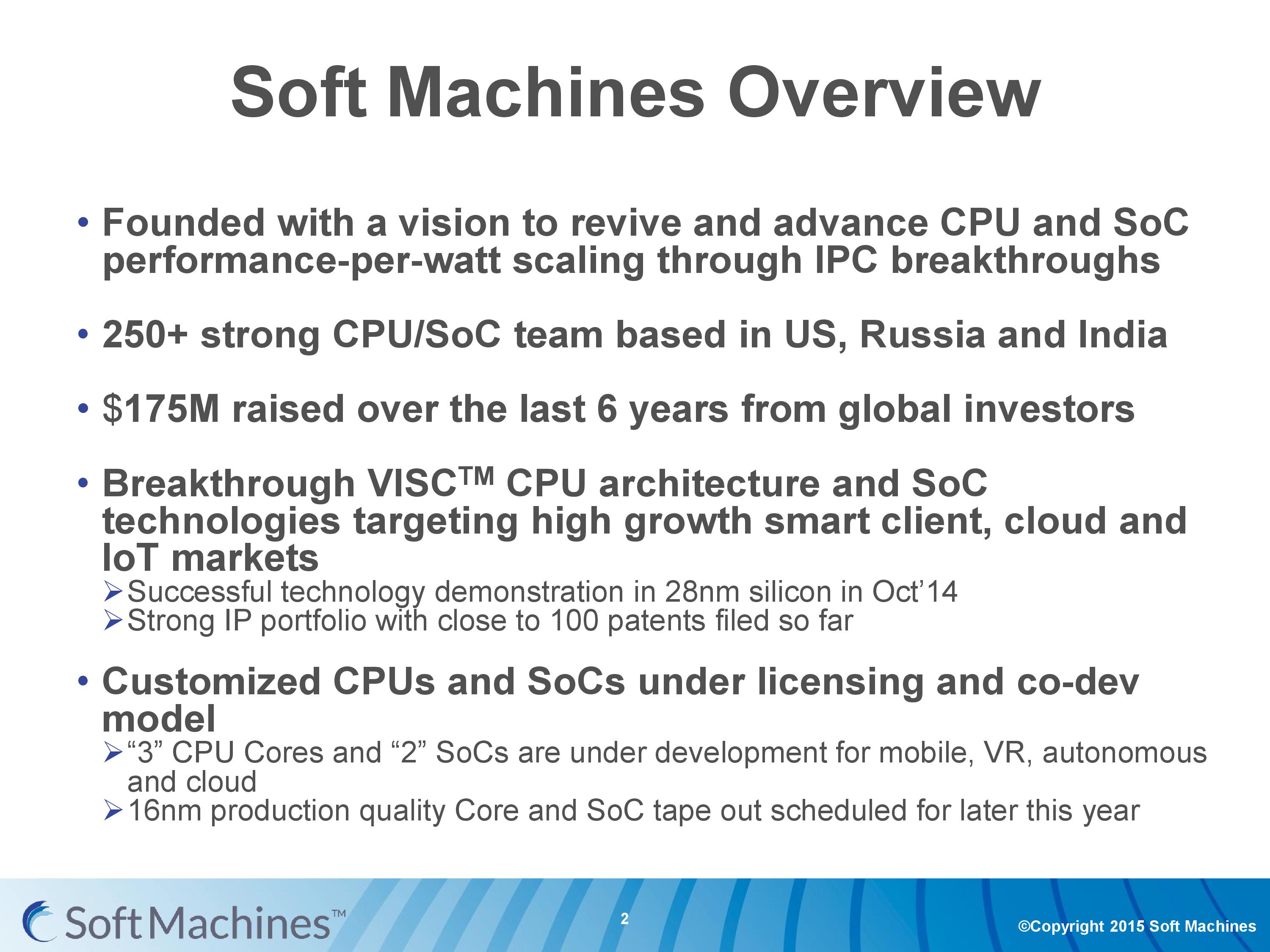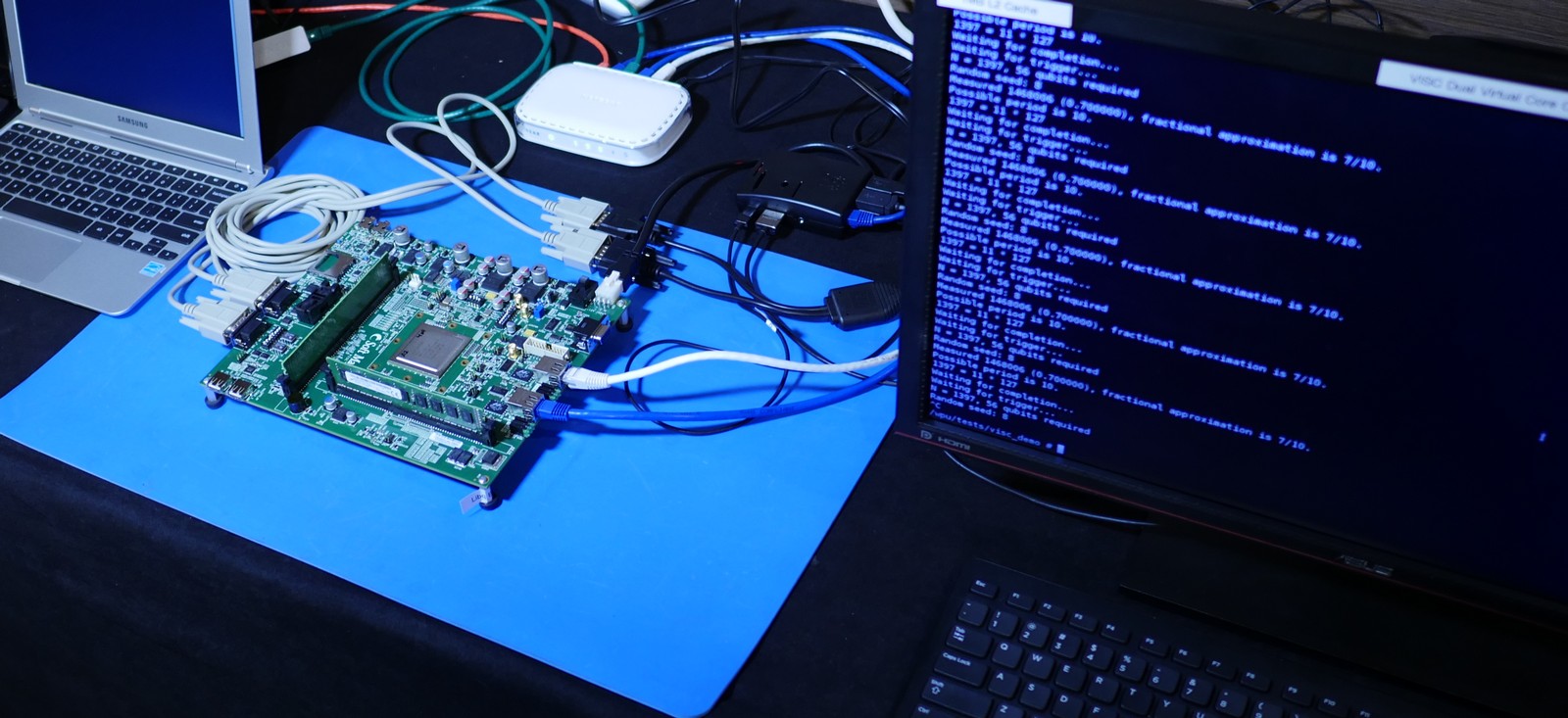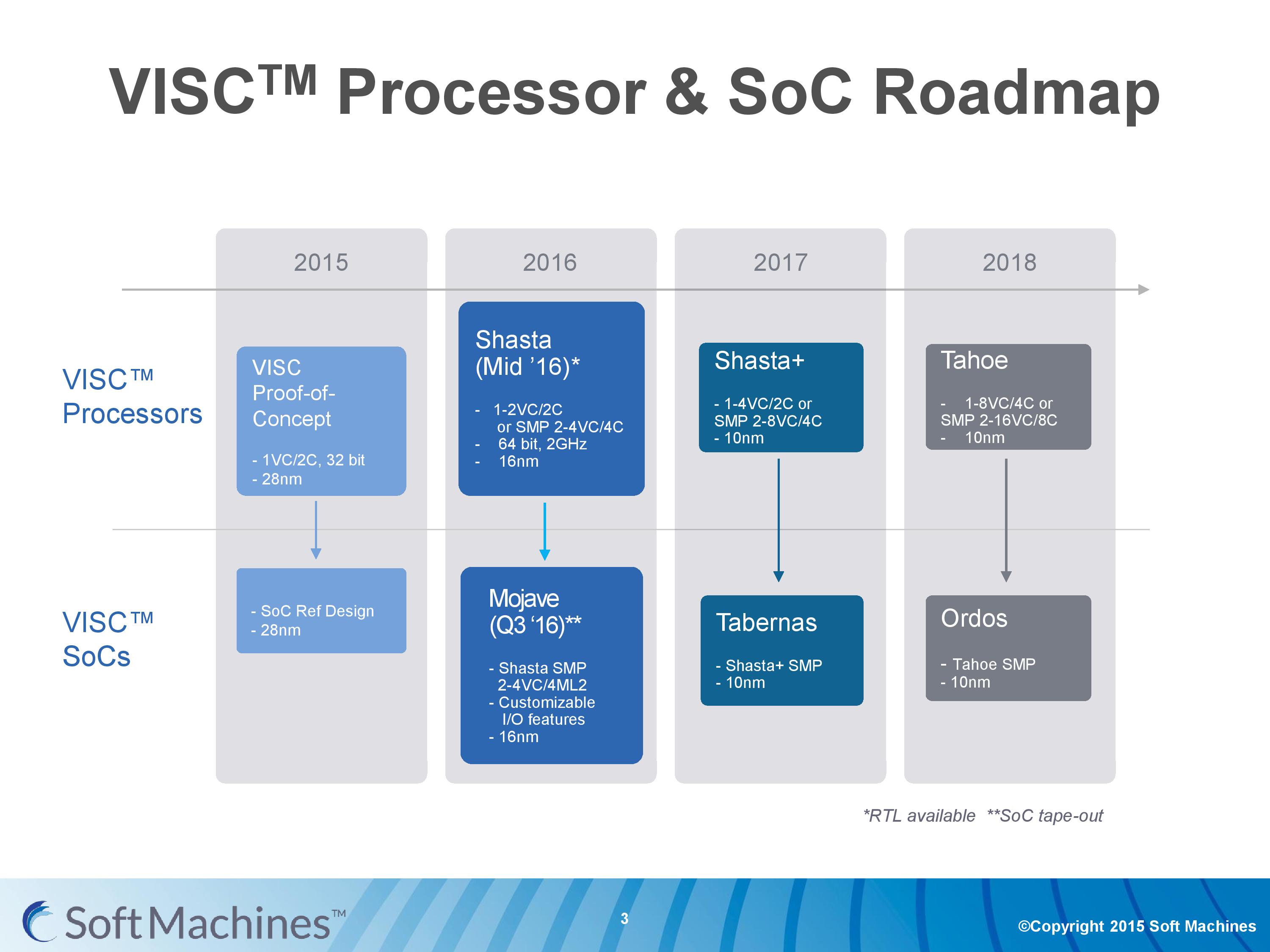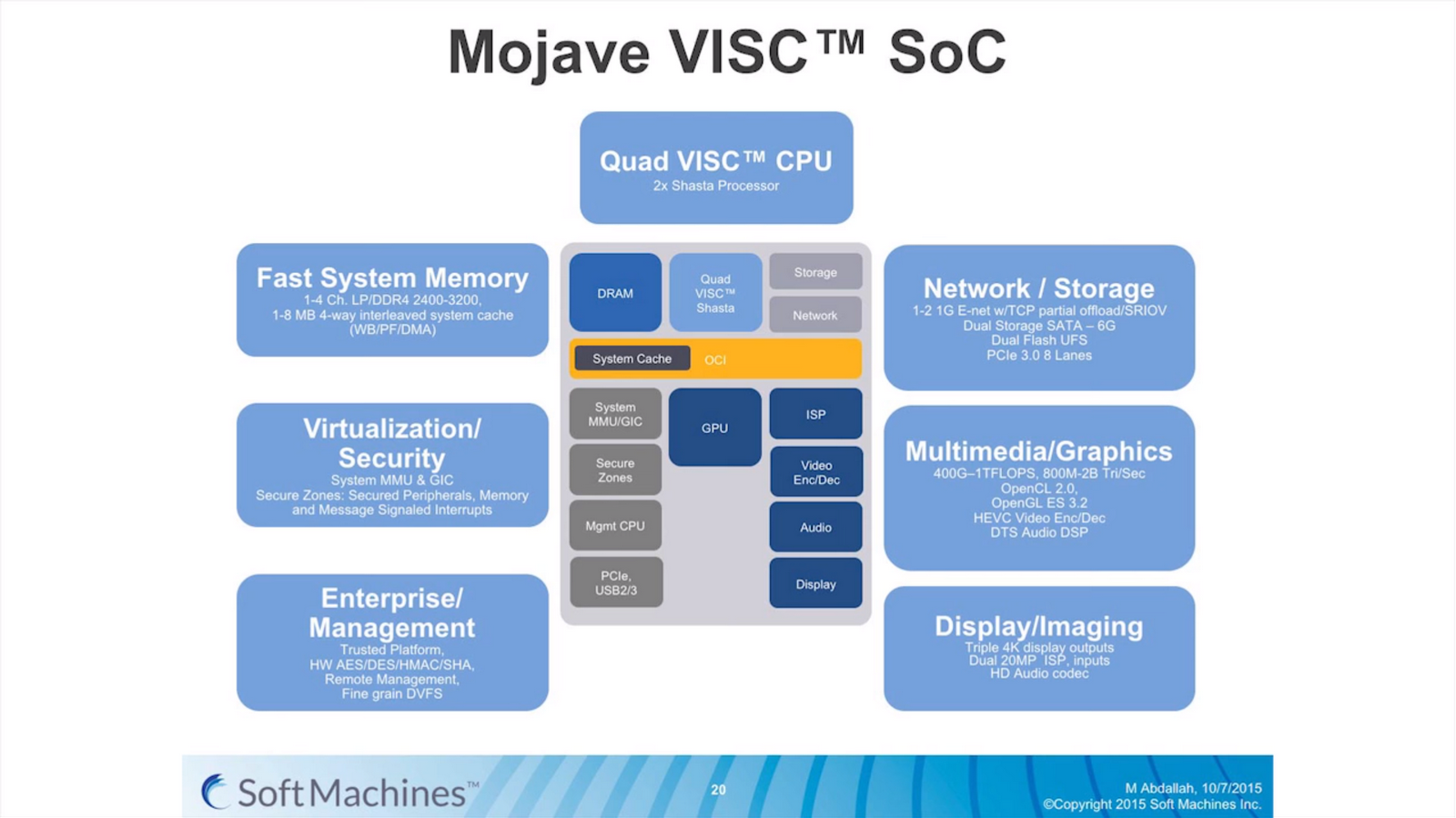Examining Soft Machines' Architecture: An Element of VISC to Improving IPC
by Ian Cutress on February 12, 2016 8:00 AM EST- Posted in
- CPUs
- Arm
- x86
- Architecture
- Soft Machines
- IPC
Soft Machines
To put it succinctly, having a thread take resources from multiple cores - when the performance can be extracted - sounds like the long-desired solution to the problem making multi-core designs more useful in lightly-threaded scenarios. Having multiple threads use resources on a single core on the same clock cycle is an even bigger leap in the same direction. Now obviously Soft Machines didn’t come up with this overnight.
Soft Machines came out of stealth mode at the 2014 Linley Conference. Their main goal was to increase performance-per-watt using better IPC designs, which is often one of the better ways if you can keep a design fed with data. One big challenge to this is that IPC has been somewhat flat these past few years - we're seeing small sub-10% yearly increases from the big players using standard designs. Soft Machines were already six years old at the time, with $150M+ raised from investors that include Samsung Ventures, GlobalFoundries, AMD, Mubadala and others (with another $25M since). If those names all seem interlinked, it’s because they all have historic business or investment dealings with each other (AMD/GloFo, Samsung/GloFo, AMD/Mubadala etc.). The team at Soft Machines is 250+ strong, with ex Intel, ex Qualcomm, ex AMD engineers on staff from processor design to platform architects. Half the staff is currently located in California.
At the 2014 conference, aside from explaining what they were doing, Soft Machines also exhibited working silicon of their design. The first generation proof of concept was fabbed at 28nm at TSMC and running at 500 MHz.
It seems odd to say that it was done at TSMC, especially with Samsung and Global Foundries as investors. We were told that this was due to timing and positioning with IP more than anything else, and the same is true for the next generation at 16nm FF+, rather than 14nm.
VISC and Roadmaps
The first generation chip wasn’t perfect – there were some design flaws in silicon that required specific workarounds relating to cache flushing and various methods, but at the time it was compared to a single thread Cortex A15 running at a similar frequency in a Samsung processor. The results with SPEC2000, SPEC2006, Denbench and Kraken gave a corresponding IPC relative to A15 of 1.5x to 7x, or as Soft Machines likes to put it: 3-4x "on average." It was estimated that access to a second physical core improves performance by an average of 50-60%, or an average IPC of 1.3 per core compared to 0.71 for Cortex A15, which explains the 3-4x average.
The roadmap for Soft Machines put their second generation VISC core, Shasta, in line for 2016. It was formally announced at the 2015 Linley Conference, with this month’s announcement being more about availability for licensing on 16FF+. The Shasta core on this node is designed as a 2C/2VC design, or two of these can be put together using a custom protocol interconnect to form a dual 2C/2VC design.
The custom interconnect fabric here is capable of over 200 GB/s, although in current designs only a single interface is present, allowing only two chips to be connected.
The dual processor design is going to be part of the Mojave IP as a fully integrated SoC.
Along with the requisite VISC cores, the Mojave SoC includes PowerVR graphics, a DDR4 memory controller, virtualization management, a PCIe root complex capable of eight lanes of PCIe 3.0, USB ports, support for SATA, UFS, OpenCL 2.0 and other standards.
Looking forward, Soft Machines would like to see production move to 10nm in 2017 to take advantage of further power and area scaling. Meanwhile along that same timeframe they also want to expand the Shasta design to allow for four virtual cores per two physical cores, essentially allowing more threads to be in flight at one time and fully use the resources better. 2018 sees the move to four physical cores and eight virtual cores per design, while still supporting SMP and SoC designs as well.















97 Comments
View All Comments
Bleakwise - Tuesday, March 14, 2017 - link
"Floating point code""Integer code"
Do you have any idea what you're talking about?
Bulldozer does "flaoting poitn code" faster than the fucking 1080Ti
At least one one thread. Unless you're going to go wide it doesn't help.
The point of this isn't to "go wide" it's to massively increase speculation ability.
The 1080Ti has ZERO speculative ability, NONE. GPUs simply don't do branching, that's not what GPUs do, they rely on ACE units and SMX units and so on to balance thousands of cores.
A CPU on the other hand has more speculative branches than cores.
SIMD and SIMT that GPUs do are not "FPU code"
FFS
dcbronco - Friday, February 12, 2016 - link
AMD helped finance this. They may already have a stake and I would bet some right to first refusal. They used their investment in HBM to get earlier access than NVIDIA, I doubt they would have invested without some sort of incentives for themselves.Bleakwise - Tuesday, March 14, 2017 - link
Of course not.bcronce - Saturday, February 13, 2016 - link
There is no such thing as a free lunch. They are trading something. Their benchmarks are for single thread performance, which the graphs showed a much greater efficiency and performance than Intel. Very impressive and I'm sure they'll be great for something.The problem is the platform sounds great for highly coupled cores and very wide single thread execution with few data dependencies. Could be great for computation.
What I'm wondering is how their platform scales for IO workloads like web servers, file servers, or event video games. Suddenly a large part of the work is communicating with other devices and synchronizing many cores.
One thing that has helped ARM for a long time is they were mostly single core and only recently multi-core. They didn't use to have a complex cache-coherency like x86. This dramatically reduced transistor counts, increase efficiency, and allowed for great decoupled core performance. But as soon as you wanted two cores to work together, it went to crap. Cache-coherency is hardware accelerated inter-core communication. Amdahl's law was not very forgiving to ARM's non-cache-coherency cores for anything except GPU like workloads.
Based on the description, VISC sounds like it needs highly couples cores to maintain low latency and high bandwidth. This is probably why they also seem to have lower frequency. Keeping many parts far away from each-other in sync takes time. But lower frequency also means lower voltage, and power consumption scales with the square of the voltage and linear with frequency.
I wonder how tightly coupled they can keep 4, 8, or 16 cores. Maybe they don't need the core counts for their target workloads or possibly they can stay competitive with a fraction the core counts by having better efficiency in power and IPC.
In the end, I'm sure they'll at least find a niche market and I'm glad some new ideas are making it out there. I wouldn't be surprised if they can take over the dual or quad core market, forcing Intel to add more cores.
Bleakwise - Tuesday, March 14, 2017 - link
It's not a "free lunch"Obviously all of this crap is going to cost DIE space, it's not free.
If all we cared about was raw processing power we'd just make 2046kb wide vector units and ignore branching and speculation all together.
Bulldozer has better theortical performance than Haswell i5s. I'd rather have the extra out of order pipes, the SMT unit to use any unused pipes, better branch prediction and so, and in the real world this stuff wins the day.
Not everyone can become a world class programmer and re-factor all their code so that it spreads across thousands of cores like it can on a GPU.
Sometimes it's not even possible. Sometimes what you need is branch prediction, branch prediction lets you see the future, LITERALLY this is what the CPU does. Obviously the more branches you predict, the more cycles you're wasting on that thread, because the more speculations you get wrong.
You also reduce the number of misses and increase cache hits.
As for coupling 4 or 16 cores, they haven't even talked about going beyond 4 cores. Obvoiusly it doesn't scale into infinity, if you're getting 90% speculative accuracy you can only gain 10% more. Spending 30% of your transitor budget to bind up 8 or 16 cores when spending 10% of your budget on 4, for a 10% performance gain would be dumb.
You'd be much better off going for more clock speed, or reducing latency, adding a victim cache, or l2 cache coherency, or beefing up the GPU, a better memory controller, or just beefing up your underlying branch predictor,
Bleakwise - Tuesday, March 14, 2017 - link
You'll never get perfect speculation anyway. Unless a language is developed that puts limits on the number of branches possible per X lines of code and keep the number of branches below the number the CPU can handle. You're going to ALWAYS have to deal with the risk of cache misses.Not sure there is even anything you could gain from 100% target prediction hit grantee beyond having no lost cycles on a miss. Getting there even through a core-binding fabric/bus like this across 16 cores would blow your transistor budget to the point that you could hardly afford a reasonable size cache in the first place.
You'd be better off just reducing the number of stages in the pipelines or just adding more pipelines to each core instead of blowing your budget on this fabric.
For example, binding together 100 in order CPUs to make a virtual 100 pipeline CPU would be ridiculously expensive and power hungry vs just having an 8 core superscaler CPU with 12 out of order pipelines in each CPU.
tipoo - Friday, February 12, 2016 - link
Question, since this is testing their core design in isolation and the rests of the package hasn't been built around it, is that accommodated for in the comparisons to other SoCs, which all have far more die area dedicated to non-core stuff than the cores?Flunk - Friday, February 12, 2016 - link
If VISC is not an Acronym then don't capitalize it, idiots.The technology looks like it could be really good, I'm hoping we see some practical applications.
smilingcrow - Friday, February 12, 2016 - link
They can capitalize it for any reason they like; it's just a word so nothing to GYKIATO (Get your kickers .... over).andychow - Friday, February 12, 2016 - link
It's an acronym, you can't trademark acronyms, so now they claim it's not an acronym. Legal bs 101.